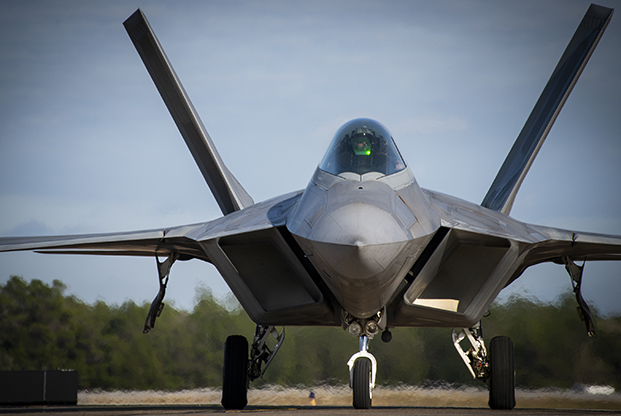
A 325th Fighter Wing F-22A Raptor evacuated from Tyndall AFB, Fla., taxis at Eglin AFB, Fla., on Nov. 20. Air Force photo by Samuel King Jr.
Tyndall AFB, Fla., which was largely destroyed by Hurricane Michael in October, would be repopulated with F-35s circa 2023 under a new plan floated Friday by the Air Force. The service wants to permanently move Tyndall’s operational F-22s to other Raptor bases while assessing which of those three installations would absorb the F-22 training mission.
The Air Force is “recommending that Congress use supplemental funding for rebuilding the base to prepare to receive the F-35 fighter” at Tyndall, the service said in a press release.
The move was prompted in part by the Air Force’s desire to consolidate its F-22s at fewer locations in order to gain efficiencies in maintenance and readiness. The Government Accountability Office recently knocked the service for inefficient distribution of its F-22s, and Defense Secretary Jim Mattis has ordered USAF to get F-22 mission capable rates up above 80 percent. The consolidation will “address key recommendations” from the GAO that “identified small unit size as one of the challenges with F-22 readiness,” USAF said in a press statement.
The Air Force also took a lot of heat for having to leave 19 F-22s at Tyndall when Hurricane Michael rolled ashore as nearly a Category 5 storm. The aircraft were either down for parts, had been cannibalized for parts themselves, or were undergoing other heavily intrusive procedures and could not be made airworthy within the 40 hours of warning time. Although about half of those remaining behind were damaged, all were made airworthy and flown out of the base within a month.
Assuming the F-22 missions move out, Tyndall would become the home of three F-35 squadrons, or about 76 aircraft.
Other Tyndall missions—the 1st Air Force Air Operations Center, the 53rd Weapons Evaluation Group, and the Air Force Civil Engineer Center—are all remaining at Tyndall, USAF said. “More than 2,000 personnel have … returned to the base,” according to the statement, and the new recommendation “only affects the operational fighter flying mission.”
“It makes sense that as we rebuild Tyndall, we build for the mission that will be there,” an Air Force spokeswoman told Air Force Magazine. USAF’s press announcement said “the move would provide benefits across the service’s fifth-generation fighter operations. Basing F-35s at Tyndall in the wake of hurricane damage allows the Air Force to use recovery funds to rebuild the base in a tailored way to accommodate the unique needs of the F-35.”
The new F-35 squadrons would go to Tyndall after the type is bedded down at other locations already announced in Alabama, Alaska, Arizona, Florida, Texas, Utah, Vermont, and Wisconsin. None of those beddowns are affected by the Friday announcement, USAF said.
The Air Force will now assess where to put the training F-22s displaced by the destruction at Tyndall. The operational Raptors of the 325th Fighter Wing went to JB Langley-Eustis, Va., while the training aircraft went to nearby Eglin AFB, Fla. “The operational F-22s formerly at Tyndall can be accommodated at other operational bases, increasing squadron size from 21 to 24 assigned aircraft,” the USAF press release noted.
The training mission would move to Langley, JB Elmendorf-Richardson, Alaska, or JB Pearl Harbor-Hickam, Hawaii, an Air Force official said. The evaluation as to where it will go has not gotten underway yet, and no timetable for completion of the assessment has been set.
“We have recommended that the best path forward to increase readiness and use money wisely is to consolidate” the F-22 mission at other F-22 bases, and “make the decision now to put the next three squadrons of F-35s beyond those for which we have already made decision at Tyndall,” Air Force Secretary Heather Wilson said.
The Air Force is “talking with congressional leaders about this plan and will need their help with the supplemental funding needed to restore the base,” she said.
“We have been given a chance to use this current challenge as an opportunity to further improve our lethality and readiness in support of the National Defense Strategy,” Chief of Staff Gen. David Goldfein said in the statement.
The service pledged to comply with all regulatory and planning processes necessary to make the basing changes. Those typically require public hearings and environmental impact statements.
As recently as November, Air Force officials were saying the F-22s would likely stay at Tyndall because of the availability of the training range over the Gulf of Mexico, allowing ample room for supersonic flights and student errors. However, an Air Force official said there are open-water ranges available at all three of the other Raptor operating locations.
The spokeswoman was unable to say whether the 12 F-22 simulators at Tyndall could be moved to another base. Tyndall boasts the largest number of F-22 simulators of all F-22 bases. The simulator facility, including its physical structure, is worth nearly $1 billion unto itself, and largely survived the hurricane.
